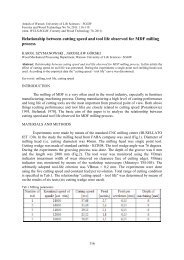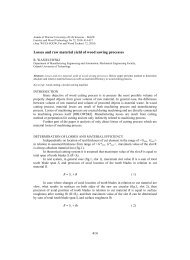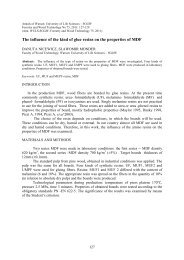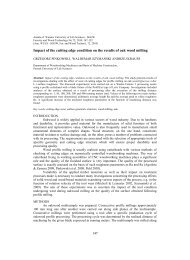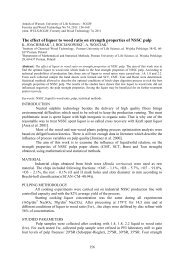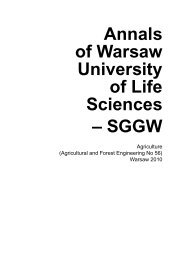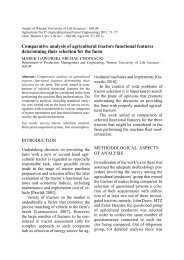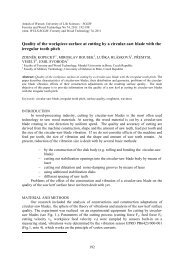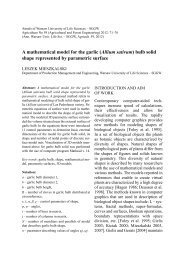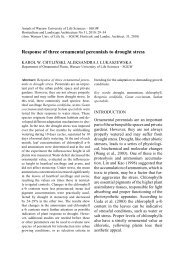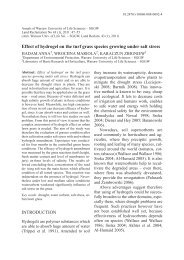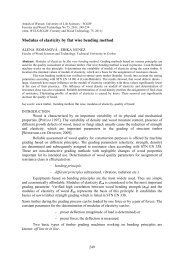Annals of Warsaw University of Life Sciences – SGGW. Animal ...
Annals of Warsaw University of Life Sciences – SGGW. Animal ...
Annals of Warsaw University of Life Sciences – SGGW. Animal ...
Create successful ePaper yourself
Turn your PDF publications into a flip-book with our unique Google optimized e-Paper software.
22 K. Fiszdon, K. Góral, J. Narojek<br />
TABLE 8. Influence <strong>of</strong> living conditions on excessive self-grooming<br />
Living condition<br />
Excessive grooming<br />
yes % no %<br />
Total<br />
Exclusively indoor 5 3.6 135 96.4 140<br />
Limited access outdoor 2 2.3 84 97.7 86<br />
Unlimited 0 0.0 43 100 43<br />
Total 7 2.6 262 97.4 269<br />
Origin <strong>of</strong> cat<br />
Cattery 0 0.0 28 100 28<br />
Born and reared in current home 0 0.0 15 100 15<br />
Born in other household 3 3.6 80 96.4 83<br />
Adopted as strays or <strong>of</strong> unknown origin 4 2.8 139 97.2 143<br />
Total 7 2.6 262 97.4 269<br />
Age at time <strong>of</strong> purchase/adoption<br />
Kitten up to 2 months 3 2.2 136 97.8 139<br />
From 2 months up to 2 years 2 1.8 107 98.2 109<br />
Over 2 years 2 10.0 18 90.0 20<br />
Total 7 2.6 261 97.4 268<br />
2 years <strong>of</strong> age, in 1 between 2 and 8 years,<br />
and in 3 over 8 years. One case related to<br />
a cat whose age was not determined. Only<br />
one <strong>of</strong> those cats was pure-bred, whereas<br />
all others were <strong>of</strong> random breeding.<br />
When analyzing possible relations<br />
between excessive grooming and living<br />
conditions, it is worth noticing that no<br />
case occurred in cats, having unlimited<br />
access to outside world, and also in cats<br />
born in their current homes or purchased<br />
from breeders (Tab. 8). Far more cases<br />
were reported with cats purchased/<br />
/adopted after they had finished 2 years <strong>of</strong><br />
age. Confining cats in limited space and<br />
change <strong>of</strong> environment may both lead to<br />
stress and it manifests itself by excessive<br />
grooming behaviors. It can be also<br />
presumed that selective breeding aims<br />
at producing individuals better suited to<br />
living as family pets.<br />
Autoaggression<br />
Only few cases were reported, therefore<br />
it was not possible to study any influence<br />
on them. Survey revealed 5 cases<br />
(1.9%), all <strong>of</strong> them in neutered individuals<br />
<strong>of</strong> European breed, adopted and <strong>of</strong><br />
unknown origin. 4 cases were attributed<br />
to cats kept permanently indoor and in<br />
one case a cat was occasionally allowed<br />
out. This clearly indicates that restricted<br />
living conditions negatively influence<br />
animal well-being, especially in case <strong>of</strong><br />
individuals used to live semi-wild for at<br />
least part <strong>of</strong> their lives.<br />
CONCLUSIONS<br />
Undesirable behaviours were observed in<br />
73% <strong>of</strong> all animals surveyed. This result<br />
is distinctly higher than any previous<br />
ones, reported by different authors.



